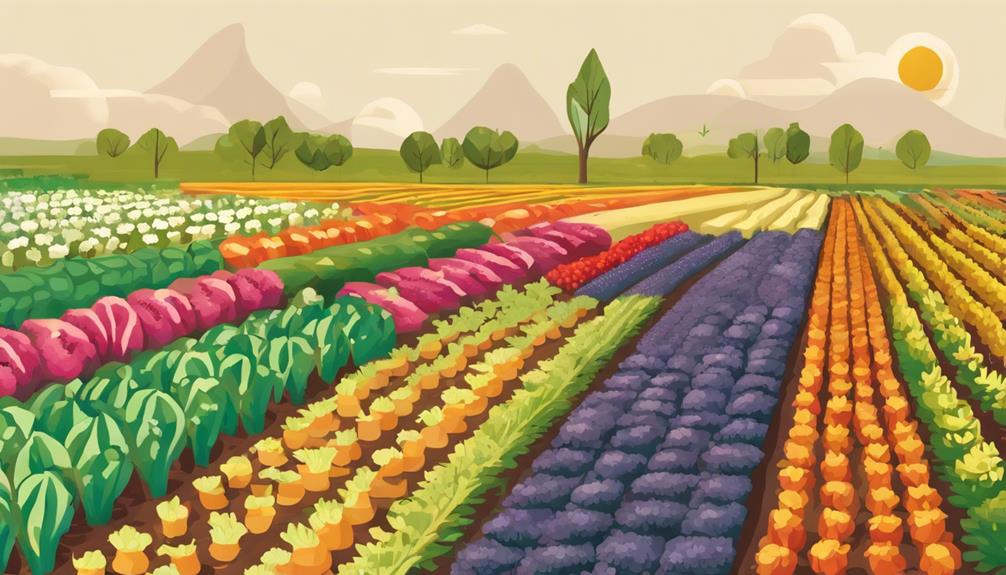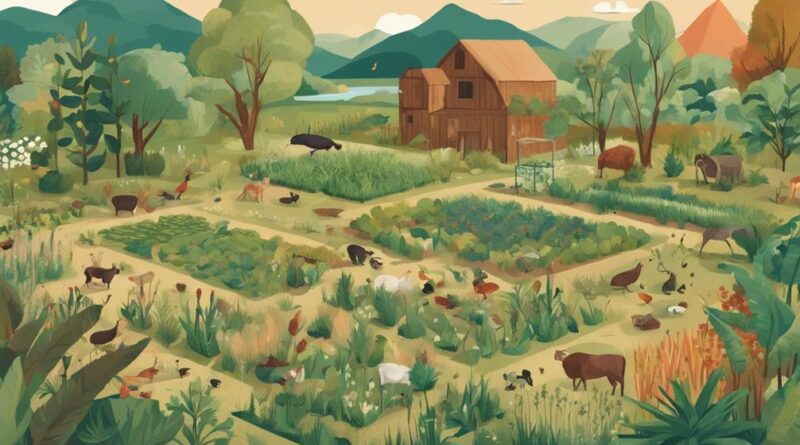What Role Does Eco-Farming Play in Boosting Biodiversity?
When considering the vast array of benefits eco-farming offers, one cannot overlook its pivotal role in boosting biodiversity. The intricate interplay between sustainable agricultural practices and the preservation of diverse ecosystems is a topic that warrants further exploration.
From fostering healthier soil to promoting the proliferation of essential pollinators, eco-farming stands as a beacon of hope for those seeking innovative solutions to environmental challenges.
But what specific techniques and approaches make eco-farming a cornerstone in the quest to enhance biodiversity?
Benefits of Organic Farming Practices
Organic farming practices consistently promote soil health and biodiversity through natural methods. By implementing eco-friendly practices and focusing on sustainable agriculture, organic farmers enhance the overall health of the ecosystem. Unlike conventional farming methods that rely heavily on synthetic chemicals, organic farming utilizes natural fertilizers like compost and manure, which enrich the soil and support a diverse range of beneficial microorganisms.
Through sustainable agriculture techniques such as crop rotation and intercropping, organic farmers maintain soil fertility without depleting its nutrients. These methods help prevent soil erosion and improve water retention, creating a more resilient environment for plant growth. By avoiding the use of harmful pesticides and herbicides, organic farming protects pollinators like bees and butterflies, essential for maintaining biodiversity in agricultural landscapes.
Furthermore, organic farming practices contribute to reducing greenhouse gas emissions and mitigating climate change. By sequestering carbon in the soil through practices like cover cropping, organic farmers play a vital role in combating global warming. The emphasis on biodiversity in organic farming not only benefits the environment but also enhances the nutritional quality of the produce. Through these eco-friendly and sustainable practices, organic farming stands as a beacon of hope for a healthier, more balanced agricultural system.
Preservation of Native Species
To ensure the continued flourishing of local ecosystems, prioritizing the preservation of native species is essential in sustainable farming practices. Native species are crucial components of ecosystems, playing unique roles in maintaining balance and biodiversity. By focusing on native habitat restoration, eco-farming contributes to the conservation of these species, ensuring their survival for future generations.
Species conservation efforts within eco-farming involve protecting and promoting the growth of indigenous plants and animals. This not only supports the native species themselves but also benefits other organisms that rely on them for food and habitat. By preserving native species, eco-farming helps recreate natural habitats that have been disrupted by conventional agricultural practices.
Native species are inherently adapted to local environmental conditions, making them more resilient to challenges such as climate change and pests. By safeguarding these species, eco-farming enhances the overall stability and sustainability of agricultural systems. Additionally, preserving native species can lead to increased pollination, pest control, and soil fertility, further boosting the productivity of eco-farming operations.
Soil Health Improvement Strategies
Improving soil health is crucial for sustainable farming practices and ecosystem vitality. One of the key strategies that farmers can implement to enhance soil health is regenerative agriculture. This approach focuses on restoring and improving soil health by using techniques such as cover cropping, crop rotation, and reduced tillage. By adopting regenerative agriculture practices, farmers can increase soil organic matter, improve soil structure, and enhance nutrient cycling, leading to healthier and more resilient soils.
Composting practices also play a vital role in improving soil health. Composting involves decomposing organic materials such as kitchen scraps, yard waste, and manure to create nutrient-rich compost. When added to the soil, compost helps enhance soil fertility, increase microbial activity, and improve soil structure. Additionally, compost acts as a natural fertilizer, providing essential nutrients to plants while reducing the need for synthetic fertilizers.
Natural Pest Control Methods
Enhancing biodiversity in your ecosystem can be effectively achieved through the implementation of natural pest control methods. By incorporating biological control and companion planting techniques, you can manage pests in an eco-friendly manner while promoting a healthy balance within your agricultural system.
- Biological Control: Introducing natural predators such as ladybugs or parasitic wasps can help control pest populations without the need for harmful chemicals.
- Companion Planting: Growing certain plants together can help deter pests. For example, planting marigolds alongside tomatoes can repel nematodes that harm the tomato plants.
- Crop Rotation: Rotating crops each season can help disrupt pest life cycles, reducing their numbers over time.
- Habitat Diversification: Creating diverse habitats in your farming area can attract beneficial insects that prey on pests. For instance, leaving patches of wildflowers can encourage predatory insects to thrive.
Enhancing Pollinator Populations
Boost the presence of pollinators in your ecosystem by implementing strategies that encourage their population growth and diversity. Pollinator conservation is crucial for maintaining healthy ecosystems and biodiversity. One effective way to enhance pollinator populations is through habitat restoration. By creating diverse and native plantings in your eco-farm, you can provide food and shelter for different pollinator species.
To support pollinator conservation, consider planting a variety of flowering plants that bloom at different times of the year. This ensures a continuous nectar and pollen source for pollinators throughout the seasons. Additionally, leaving some areas of your farm wild or uncultivated can create ideal habitats for pollinators to nest and reproduce.
Another way to boost pollinator populations is by minimizing pesticide use. Chemical pesticides can harm pollinators and disrupt their natural behaviors. Instead, opt for organic and natural pest control methods to protect both pollinators and other beneficial insects in your ecosystem.
Furthermore, you can install bee hotels or nesting boxes to provide shelter for solitary bees and other pollinators. These structures mimic natural nesting sites and can help increase the nesting success of pollinators in your eco-farm.
Agroecological Techniques for Biodiversity
Consider incorporating agroecological techniques into your farming practices to promote and maintain biodiversity within your ecosystem. By implementing these methods, you can create a more sustainable and diverse environment for both flora and fauna.
Here are some key agroecological techniques to enhance biodiversity:
- Habitat Restoration: Restoring natural habitats within your farmland can provide shelter and resources for a variety of species, contributing to overall biodiversity.
- Wildlife Corridors: Designing wildlife corridors through your agricultural land allows for the safe movement of wildlife, enabling gene flow and promoting species diversity.
- Agroforestry: Integrating trees and shrubs into your farming system through agroforestry practices not only enhances soil health and water retention but also provides habitats for birds, insects, and other wildlife.
- Sustainable Agriculture: Adopting sustainable agricultural practices such as crop rotation, organic farming, and minimal tillage helps maintain soil fertility, reduces chemical inputs, and supports a healthy ecosystem.
Incorporating these agroecological techniques can't only benefit your farm's productivity but also contribute to the conservation of biodiversity on a larger scale. By working in harmony with nature, you can create a thriving ecosystem that supports a wide array of plant and animal life.
Crop Rotation and Diversification

To further cultivate biodiversity and sustain your ecosystem, implementing crop rotation and diversification techniques in your farming practices is essential. Crop rotation involves changing the type of crops grown in a particular field seasonally or annually. This practice helps improve soil health, reduce pests and diseases, and enhance nutrient availability. By rotating crops, you can prevent the depletion of specific nutrients from the soil, leading to improved yields over time.
Diversifying your crops not only benefits the environment but also your farm's productivity. By planting a variety of crops, you create a more resilient ecosystem that can better withstand external pressures such as climate change or pest outbreaks. Different crops have different nutrient requirements, root structures, and growth patterns. This diversity can help improve soil structure, prevent erosion, and promote beneficial interactions among plants.
Incorporating crop rotation and diversification into your farming practices aligns with sustainable principles. These methods reduce the reliance on chemical inputs, promote natural pest control mechanisms, and enhance overall ecosystem health. By embracing these sustainable practices, you contribute to the long-term viability of your farm while supporting biodiversity. So, consider integrating crop rotation and diversification techniques into your farming methods to foster improved yields and sustainable practices.
Water Conservation in Organic Farming
Implementing efficient water conservation techniques is crucial in organic farming to promote sustainability and preserve natural resources. By incorporating irrigation efficiency and sustainable practices, organic farmers can significantly reduce water usage while maintaining crop productivity.
Here are some key water-saving techniques that align with environmental stewardship:
- Drip Irrigation Systems: Utilizing drip irrigation systems delivers water directly to the roots of plants, minimizing water wastage through evaporation or runoff.
- Mulching: Applying mulch around plants helps retain soil moisture, reducing the frequency of irrigation needs.
- Rainwater Harvesting: Collecting and storing rainwater for later use in irrigation reduces reliance on freshwater sources.
- Companion Planting: Planting complementary species together can help create a microclimate that retains moisture, reducing overall water requirements.
Frequently Asked Questions
How Can Eco-Farming Contribute to the Overall Health of Local Ecosystems Beyond Just Biodiversity?
When it comes to the overall health of local ecosystems, eco-farming goes beyond just boosting biodiversity.
By promoting resilience and enhancing soil health, eco-farming helps ecosystems adapt to challenges like climate change and pollution.
The diverse plantings and sustainable practices in eco-farming create healthy soil, which in turn supports a thriving ecosystem.
What Are Some Potential Challenges or Limitations That Eco-Farming Practices May Face in Different Regions or Climates?
When it comes to challenges in eco-farming, regions and climates can throw you curveballs. But don't worry, adaptation strategies are key to overcoming these obstacles.
Challenges like water scarcity, soil erosion, or pest management may vary depending on where you are. By implementing innovative techniques tailored to specific conditions, you can boost resilience and sustainability in your eco-farming practices.
Just remember, adaptability is your best friend in the face of these challenges.
Are There Any Specific Certifications or Standards That Farmers Need to Adhere to in Order to Be Considered Eco-Farmers?
To be recognized as eco-farmers, you must meet specific certification requirements and adhere to farming standards. These guidelines ensure sustainable practices, biodiversity conservation, and environmental protection.
Certification bodies evaluate factors such as soil health, water management, and pesticide use to determine if farmers qualify. By meeting these standards, eco-farmers contribute to a healthier ecosystem and promote biodiversity within their agricultural practices.
How Do Socio-Economic Factors Play a Role in the Adoption and Success of Eco-Farming Practices?
When it comes to eco-farming practices, socio-economic barriers can heavily influence adoption and success. Factors like access to resources, financial support, and education can impact how readily farmers engage in these sustainable methods.
Community engagement plays a vital role in providing support networks and sharing knowledge, helping to overcome these obstacles. By fostering inclusive and supportive communities, eco-farming practices can thrive and contribute to a more sustainable agricultural landscape.
What Ongoing Research or Developments Are Currently Being Explored in the Field of Eco-Farming to Further Enhance Biodiversity and Sustainability?
When it comes to ongoing research in eco-farming, you'll find exciting trends and technological innovations that aim to enhance biodiversity and sustainability. Researchers are exploring new methods to promote a healthy ecosystem and increase crop resilience.
Innovations like precision farming and agroforestry are gaining traction, showing promise in boosting biodiversity while maintaining productivity.
Stay updated on these developments to see how eco-farming continues to evolve for a greener future.
Conclusion
In conclusion, eco-farming plays a crucial role in boosting biodiversity by promoting organic farming practices, preserving native species, improving soil health, utilizing natural pest control methods, enhancing pollinator populations, and implementing agroecological techniques.
By incorporating crop rotation, diversification, and water conservation strategies, eco-farming helps create a sustainable environment that supports a rich and diverse ecosystem.
Embracing eco-friendly farming practices is key to protecting our planet's biodiversity for future generations.
